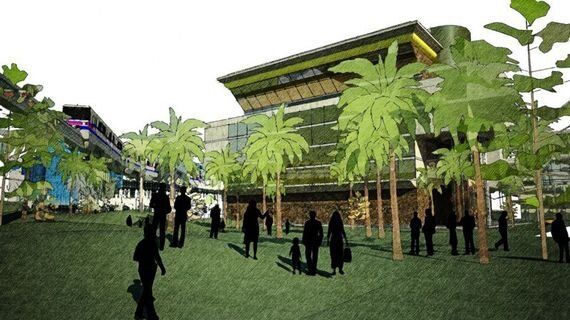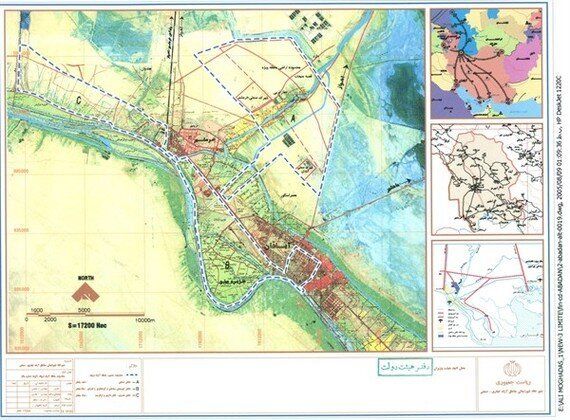
AFZ: Plans for a playground for the rich, created by ethnocide
The Iranian regime has stolen the land of thousands of indigenous Ahwazi Arab farmers located in the Arvand Free Zone (AFZ) and is now inviting them back as serfs.
The "moderate" President Hassan Rouhani's senior economic advisor Akbar Turkan spoke casually and romantically of the Iranian regime's anti-Arab ethnic cleansing programme on television this week. He urged citizens from around the country to buy AFZ land that has been forcibly acquired from Arab farmers by the regime and turn it into their personal gardens.
When asked what would happen to the locals, Turkan suggested they be made the gardeners. Having lost their wealth and been forcibly displaced from their land to live a life of misery in slum neighbourhoods, one-time farmers are now being invited back as the Arab slaves of their Persian masters.
Akbar Turkan: turning farmers into serfs
Ethnocide in a free zone
The AFZ has seen the mass expulsion of Ahwazi Arabs, the destruction of their villages and the creation of an exclusive military-industrial zone. In all, up to 500,000 indigenous Ahwazi Arabs are being displaced by the creation of a 5,000 square kilometres security zone along the left bank of the Shatt al-Arab waterway, of which the AFZ is just a part. Due to the international sanctions regime, investment in the zone has been lacklustre, but relaxations in sanctions are now drawing interest from China and there are plans for an Chinese-Iranian industrial zone in the AFZ.
"Free zones" throughout the world are often characterised by extreme violence and exempting authorities and investors of their responsibilities to the local population. Forced displacement, the waiving of labour rights, money laundering, environmental destruction, militarisation and grotesque tax-free profiteering are standard features of free zones across the world.

The Arvand Free Zone covers a large area of land between the cities of Mohammerah and Abadan
In its violence and the human catastrophe for the enrichment of Iran's rulers, the AFZ is on a par with the Serbian cleansing of Kosovo's ethnic Albanian population. But it is merely a part of a long-standing plan by the Iranian regime to reduce the indigenous Arab to a third of the population of "Khuzestan" province, revealed in a letter by former Vice-President Mohammad-Ali Abtahi that was leaked in 2005, sparking the Ahwazi intifada.
The fascist dream
The humiliation instilled by the plunder and state robbery seen in the Arvand Free Zone is justified in terms of "economic development" and modernisation, but is rooted in national ethnic chauvinism that regards the indigenous inhabitants with contempt.
The ethnocide of Ahwazi Arabs goes back further than the current regime. It is the culmination of a national dream - a nightmare for the Arabs - that began with the Pahlavi dynasty in 1925 and remains central to the unquestioned prejudices that underpin national life.
A sense of national victimhood was cultivated and exploited by career soldier and military coup leader Reza Mirpanj who became the founder of his own Pahlavi dynasty (1925-79) and the inventor of modern Iranian nationalism. Economically and politically, the country was weak and on its knees. Persia was the first victim of the nascent Cold War between the West and Soviet communism. The Great Famine of 1917-19, which was largely the result of British and Russian intervention, wiped out a sizeable portion of the population of Persia and nearly destroyed the country.
The newly enthroned Reza Shah Pahlavi, backed by pseudo-academic scholars, sought to restore pride to a broken country. He adopted proto-fascist notions of racial supremacy that were already taking hold of Europe.
The Persian empire belatedly entered the modern era as "Iran", land of the Aryans, the official name established by the Pahlavi regime. Unfortunately for the autonomous region of Arabistan in the southwest of the Persian empire, the Arabs as non-Aryans were the chosen enemy in the new national story weaved by the Pahlavi regime.
What the nationalists could not find in ancient texts such as Ferdowsi's Shahnameh, which overflows with bilious hatred of Arabs, they forged. Those texts that contradicted national myths were destroyed. A famous example is the forged letter of Yazdgerd III, the last Sassanid emporer, to Caliph Omar". This violently anti-Arab screed circulates among Persian chauvinists in the same way as the Protocols of the Learned Elders of Zion still forms the basis of Antisemitism in the West.
Persian monarchists rely on myth and forgery to justify hatred of Arabs
Portrayed as aliens and invaders, the indigenous Arabs lost control over the resources of their homeland. Sheikh Khazaal, the dynastic ruler of the emirate of Al-Mohammerah who presided over the establishment of Persia's oil industry, was deposed and his seat of power was renamed "Khorramshahr". Other place names were also Persianised, Arab tribal sheikhs lost power, farmers lost land and Arabistan became "Khuzestan", a place of plunder for whatever tyrant was ruling in Tehran, whether shah or mullah.
Khazaal and previous rulers of Arabistan have been virtually eradicated from history, their influence and importance destroyed as successive regimes have destroyed archives, literature, monuments and palaces.
The AFZ is a final assault on an indigenous population that has been subjected to 90 years of ethnocide. And it is a policy that is supported by both the regime and its self-proclaimed "opposition" - the hapless Green Movement and embittered monarchists, both of which are upheld by Western governments as agents of change.
Ahwazi Arabs: pushed to the margins

Ahwazi Arabs are Iran's most restive and rebellious people
Once a relatively wealthy population, Ahwazi Arabs now live on the social, cultural, economic and political margins of Iranian national life, both in Iran and within the diaspora where racial chauvinism thrives. Ahwazi Arabs paid a massive price for the tragedy of the Great Famine, even though their farms supplied much of the grain that kept many Persians alive.
In spite of miseries they suffered in the Iran-Iraq War that was fought in their homeland, the Ahwazi Arabs remain reviled, distrusted or patronised by the ethnic Persian intelligentsia, both at home and abroad.
The silence of the ethnic Persian-dominated Iranian "opposition" over the AFZ reveals the superficiality of their human rights agenda. Any serious opposition movement needs to first confront the racist myths that support nationalist ideologies that are used as a ruse for the violent robbery of the Ahwazi Arab homeland's resources.
Pushed to the margins by successive regimes, oppressed Ahwazi Arabs are creating their own alternative narrative. A largely ignored struggle is now finding its feet within the story of contemporary Arab struggles against tyranny. Enslavement is being answered by a liberation movement that threatens to rock Iran. The unreformed chauvinism that sought to unify Iran after the tragedy of the Great Famine could, a century later, lead to Iran's extinction.